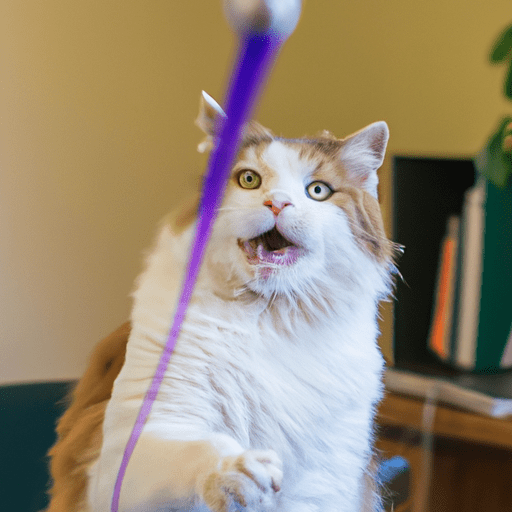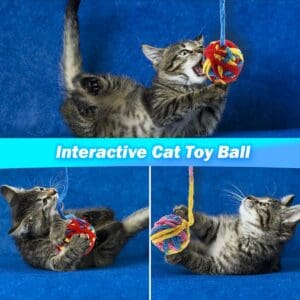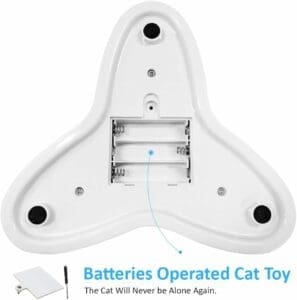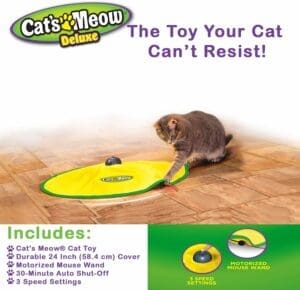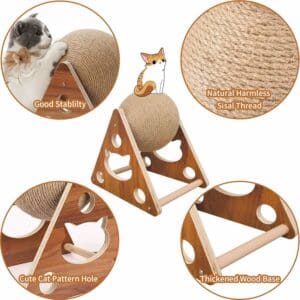Is your feline friend in need of some entertainment? Look no further! In this article, we will dive into the world of cat playtime and explore different ways to keep your furry companion entertained. From interactive toys to engaging play sessions, we’ve got you covered. So grab a cup of tea, sit back, and let’s discover how you can ensure your cat’s playtime is filled with fun and excitement.
Benefits of Playtime for Cats
Physical exercise
Playtime is essential for your cat’s overall health and well-being. Engaging in physical activities helps your furry friend burn off excess energy, maintain a healthy weight, and prevent obesity-related health issues. Whether it’s chasing after a wand toy or pouncing on a feather teaser, these play sessions provide much-needed exercise for their muscles and joints. Regular playtime can improve their agility, flexibility, and overall physical fitness.
Mental stimulation
In addition to physical exercise, playtime also serves as a mental workout for your cat. Cats are intelligent creatures that thrive on mental challenges. Engaging them in interactive play helps stimulate their problem-solving skills and keeps their minds sharp. Toys that require them to figure out a puzzle or navigate through obstacles can provide mental enrichment and prevent boredom. Mental stimulation is vital for their overall cognitive development and can even help prevent behavioral issues like destruction or aggression.
Bonding with the owner
Playtime is not just about physical and mental stimulation; it’s also an excellent opportunity for you to strengthen your bond with your furry friend. Engaging in interactive play with your cat allows you to spend quality time together, fostering a deeper connection and trust. By actively participating in their play sessions, you become their playmate and source of entertainment. This bonding experience can help build a stronger relationship and enhance the overall well-being of both you and your cat.
Understanding Your Cat’s Play Preferences
Different play styles
Just like humans, cats have different play styles and preferences. Some cats may enjoy playing chase and pounce games, while others may prefer stalking and capturing prey-like toys. Understanding your cat’s individual play style is essential to ensure they enjoy their playtime to the fullest. Observe their behavior during play sessions and take note of the toys and activities that excite them the most. By tailoring playtime to their preferences, you can create a more enjoyable and engaging experience for your feline friend.
Finding the right toys
To keep your cat entertained during playtime, it’s crucial to provide them with toys that meet their specific needs and preferences. From interactive wand toys to feather teasers, there is a wide variety of toys available to cater to different play styles. Experiment with various toys to discover which ones capture your cat’s attention and excite them the most. Rotating toys regularly can also help keep their interest and prevent boredom. Additionally, ensure that the toys are safe, free of small parts that can be swallowed, and made from non-toxic materials.
Observing body language
During playtime, it’s important to pay attention to your cat’s body language. Cats communicate through their body postures and expressions, and understanding these cues can help you gauge their level of enjoyment and comfort during play. Signs of engagement include dilated pupils, pouncing, and swatting at toys. On the other hand, if your cat starts to flatten their ears, hiss, or show signs of aggression, it’s essential to give them space and reassess the play activity. Respecting your cat’s boundaries and adjusting your approach accordingly ensures a positive play experience for both of you.
Creating a Safe and Stimulating Play environment
Designating play areas
Creating designated play areas within your home can help promote a structured playtime routine for your cat. These areas can be designated rooms or specific corners where you keep their toys and encourage play. By associating these areas with playtime, you can help stimulate their excitement and anticipation when they enter these spaces. Designating play areas also helps minimize any potential disruptions or distractions that may hinder their playtime experience.
Choosing appropriate toys
When selecting toys for your cat, it’s important to consider factors such as their age, size, and play preferences. Some cats may enjoy toys they can bat around, while others may prefer toys they can chase and capture. Interactive toys, like puzzle feeders or treat-dispensing toys, can be beneficial for both mental stimulation and physical exercise. Additionally, toys with different textures, sounds, and movements can provide variety and keep your cat engaged. Always choose toys that are safe, durable, and free of small parts that can be ingested.
Safety precautions
While playtime is meant to be fun and enjoyable, it’s essential to prioritize your cat’s safety. Avoid using strings or cords as toys, as they can pose a choking hazard if swallowed. Regularly inspect toys for any signs of wear and tear, and replace them if they become damaged. Be cautious with toys that have small parts or loose threads that can be easily chewed off. Additionally, ensure that play areas are free of any potential hazards, such as toxic plants or open windows. By taking necessary safety precautions, you can create a secure and stimulating play environment for your cat.
Interactive Play Ideas
Wand toys
Wand toys are a fantastic way to engage your cat in interactive play. These toys consist of a long rod with a dangling object attached to a string, mimicking the movement of prey. You can make the toy move in erratic patterns, encouraging your cat to chase, pounce, and engage their natural hunting instincts. Wand toys are great for both physical exercise and mental stimulation, as they require coordination and focus. Remember to supervise play with wand toys and avoid leaving them unattended, as strings and cords can be dangerous if swallowed.
Feather teasers
Feather teasers are another popular interactive toy that cats love. These toys typically consist of feathers attached to a string or stick, resembling birds or insects. Gently waving the feather teaser can entice your cat to pounce and leap, replicating the thrill of hunting. Feather teasers are lightweight and easy to manipulate, making them ideal for interactive play sessions. Playing with feather teasers can help your cat release pent-up energy and provide an outlet for their natural predatory instincts.
Ping pong balls
Simple yet effective, ping pong balls are inexpensive toys that can provide hours of entertainment for your cat. These lightweight, bouncy balls are easy for cats to bat around and swat with their paws. The unpredictable movement of the ball stimulates your cat’s curiosity and encourages them to engage in playful interaction. You can create a mini-obstacle course using cardboard tubes or set up a makeshift “soccer” game, allowing your cat to chase and bat the ping pong ball around.
Laser pointers
Laser pointers can be an exciting and interactive playtime option for your cat. The elusive red dot created by the laser stimulates their natural prey drive, encouraging them to chase and pounce. However, it’s vital to use laser pointers responsibly and never shine the laser directly into your cat’s eyes. Always end the play session with a tangible reward, such as a treat or a toy, to prevent frustration caused by the inability to “capture” the laser dot. Remember, laser pointers should supplement other interactive play activities and not be the sole source of playtime.
DIY Cat Toys
Cardboard boxes with holes
One man’s trash can be a cat’s treasure! Simple household items like cardboard boxes can make for fantastic DIY cat toys. Cut holes into the sides of a cardboard box and place small toys or treats inside. Your cat will enjoy poking their paws through the holes, attempting to catch the hidden treasures. This not only provides mental stimulation but also satisfies their natural curiosity and desire to explore enclosed spaces. Cardboard boxes also make excellent hiding spots for games like hide and seek!
Paper bags with crumpled paper
Paper bags are another readily available item that cats find intriguing. Flatten a paper bag and crumple up some scrap paper into balls. Toss the crumpled paper inside the bag and let your cat have a playful “hunt.” The rustling sound and unpredictable movement of the paper balls will evoke your cat’s predatory instincts, keeping them entertained for hours. Always ensure that any handles or strings on the bag are removed to prevent entanglement or choking hazards.
Homemade puzzle toys
Engage your cat’s problem-solving skills with homemade puzzle toys. Take an empty plastic water bottle and make small holes in it. Fill it with dry cat treats or kibble and watch as your cat figures out how to release the treats through the holes. You can also create a simple puzzle by placing treats in an egg carton and closing the lid. Your feline friend will have a blast discovering how to open the individual sections to access the hidden treats. Homemade puzzle toys provide both mental stimulation and a challenge for your clever kitty.
Indoor Playtime Activities
Hide and seek
Hide and seek is a classic game that can be adapted to play with your cat indoors. Find a variety of hiding spots around your home, such as behind furniture or under blankets. Encourage your cat to search for you by softly calling their name or making enticing noises. As they find you, reward them with praise or a treat. You can also reverse the roles and let your cat hide while you search for them. This game is not only fun but also encourages mental stimulation and provides a bonding experience between you and your cat.
Treasure hunt
A treasure hunt is a stimulating indoor play activity that taps into your cat’s natural instincts. Hide small treats or toys throughout your home, making sure they are in safe and accessible locations. Encourage your cat to “hunt” for the hidden treasures by using verbal cues or showing them the initial hiding spot. Your cat will enjoy the challenge of discovering each hidden reward and satisfying their natural curiosity. Regular treasure hunts can help keep your cat mentally engaged and prevent boredom.
Catnip toys
Catnip toys are a paw-some addition to your indoor playtime routine. Catnip is an herb that produces a natural chemical reaction in cats when they come into contact with it. Many cats are highly attracted to catnip and become energized or exhibit playful behavior when exposed to it. Providing catnip toys during playtime can enhance their enjoyment and encourage them to engage in interactive play. Catnip toys are available in various forms, including plush toys, kicker toys, and even refillable catnip pillows.
Outdoor Playtime Considerations
Supervised outdoor play
While indoor playtime is essential, supervised outdoor play can provide additional mental and physical stimulation for your cat. Whether you have a securely fenced yard or opt for a controlled outdoor space like a catio, supervised outdoor play allows your cat to experience nature and engage their natural instincts. Keep in mind that outdoor play should be conducted under close supervision to ensure your cat’s safety. Be cautious of potential dangers, such as poisonous plants or other animals, and always bring your cat back indoors after playtime.
Creating a catio
A catio is a safe and enclosed outdoor area designed specifically for cats. It allows your feline friend to experience the sights, sounds, and smells of the outdoors while remaining protected from potential hazards. A catio can be as simple as a screened-in porch or as elaborate as a custom-built enclosure complete with shelves, ramps, and hiding spots. It provides an enriching environment for your cat to explore and engage in play, all while ensuring their safety and minimizing the risks associated with unsupervised outdoor time.
Playing during the cooler hours
If you live in a region with hot or humid climates, it’s important to consider the temperature when allowing your cat to engage in outdoor play. Cats can be sensitive to extreme heat and may be prone to heatstroke or dehydration. To keep your cat safe, schedule outdoor playtime during the cooler hours of the day, such as early morning or evening when temperatures are lower. Providing access to shaded areas, fresh water, and checking for signs of overheating, such as excessive panting, will help ensure a safe and enjoyable outdoor play experience for your furry friend.
Playtime Essentials for Multi-Cat households
Separate play sessions
In multi-cat households, it’s crucial to ensure that each cat gets their fair share of playtime. Cats have different play styles and preferences, and some may be more dominant or assertive during play. To avoid conflicts or competition, it’s best to engage in separate play sessions with each cat. This allows them to play at their own pace and enjoy individual attention. Rotate playtimes throughout the day to ensure everyone gets their turn and create a harmonious play experience for all cats involved.
Managing territorial behavior
Cats are naturally territorial animals, and playtime can sometimes trigger their competitive instincts. It’s essential to manage any territorial behaviors that may arise during play. If you notice signs of aggression or tension between your cats, separate them and provide each cat with their own play area and toys. In some cases, using interactive toys from a distance, such as wand toys or laser pointers, can prevent territorial disputes and promote equal play opportunities. Monitoring your cats’ interactions and intervening when necessary helps maintain a safe and balanced play environment.
Rotation of toys
To keep playtime engaging and prevent boredom, it’s beneficial to rotate toys between your cats. Each cat may have their preferences, and swapping toys can provide variety and stimulate their curiosity. Additionally, rotating toys helps prevent possessiveness and territorial behavior associated with individual toys. By consistently introducing new toys or reintroducing familiar toys after a break, you can promote fairness and ensure that each cat has opportunities to play with different toys.
Transitioning Playtime into Relaxation
Calming activities
After an active play session, it’s important to help your cat transition into a more relaxed state. Calming activities, such as gentle brushing, massage, or slow-paced interactive play, can help your cat wind down and reduce any remaining pent-up energy. Using calming scents, like lavender or chamomile, in their environment or utilizing pheromone diffusers can also help create a calm and soothing atmosphere. Understanding your cat’s individual preferences and providing them with the appropriate calming activities can help promote a sense of relaxation and contentment.
Napping areas
Cats are known for their love of napping, and providing designated napping areas is crucial for their overall well-being. After playtime, ensure that your cat has access to comfortable and cozy napping spots. Their napping areas should be quiet, free of disturbances, and away from areas of high human or pet traffic. Providing soft blankets, pillows, or a cat bed in these areas will encourage your cat to relax and recharge after an energetic play session. Remember to maintain a clean and odor-free environment to ensure their napping spots remain inviting and comfortable.
Mimicking natural hunting behavior
To help your cat fully unwind after playtime, consider incorporating activities that mimic their natural hunting behavior. Providing puzzle feeders or treat-dispensing toys encourages them to “hunt” for their food and engages their problem-solving skills. You can also scatter kibble or treats in various locations around your home, creating a mini-treasure hunt for your cat. Engaging in these activities satisfies their instinctual drive to hunt and provides mental stimulation, ultimately promoting relaxation and satisfaction.
Common Playtime Mistakes to Avoid
Forcing play
It’s crucial to remember that playtime should be a voluntary and enjoyable activity for your cat. Avoid forcing them to engage in play or continuing play sessions when they show signs of disinterest or fatigue. Respect their boundaries and allow them to dictate the duration and intensity of play. Forcing play can create negative associations with playtime and cause stress or anxiety in your cat. Pay close attention to their body language and take cues from them to ensure playtime remains a positive experience.
Neglecting playtime
Regular playtime is essential for maintaining your cat’s physical and mental well-being. Neglecting playtime can result in boredom, restlessness, or the development of undesirable behaviors. Consistency is key, so strive to incorporate daily play sessions into your cat’s routine. Even short and frequent play sessions throughout the day can make a significant difference in your cat’s overall happiness and satisfaction. Remember, playtime is not just a luxury; it’s a necessity for your cat’s overall health and happiness.
Inappropriate play behaviors
During playtime, it’s crucial to discourage any aggressive or rough play behaviors. Biting, scratching, or excessive aggression towards toys or humans should not be encouraged or tolerated. If your cat displays inappropriate play behaviors, immediately redirect their attention to an appropriate toy or activity. Refrain from using your hands or feet as play objects, as this can lead to confusion and reinforce undesirable behaviors. Consistently reinforce positive play behaviors and redirect any negative behaviors to ensure a safe and enjoyable playtime experience for everyone involved.
In conclusion, playtime is a crucial aspect of your cat’s overall well-being. Engaging in interactive play provides them with physical exercise, mental stimulation, and an opportunity to bond with their owner. Understanding your cat’s play preferences, creating a safe play environment, and incorporating a variety of playtime activities all contribute to a fulfilling play experience. By prioritizing playtime and avoiding common mistakes, you can ensure that your furry friend remains entertained, stimulated, and content. So grab their favorite toy, create a designated play area, and embark on a playful journey with your feline friend – the joy and benefits are boundless!

